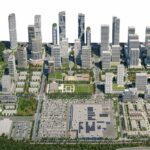
The impact of preconstruction developments on Canadian neighborhoods
August 8, 2023Explore how preconstruction developments in Canadian neighbourhoods affect.
Over the past few years, there has been a growing trend of pre-construction developments in Canadian neighbourhoods. These developments involve the construction of residential or commercial buildings in areas that are still undergoing development. This article examines the effects of preconstruction developments on Canadian neighbourhoods from different viewpoints.
Effects and Perspectives
The transformation of a neighbourhood’s skyline significantly affects preconstruction developments. These projects can greatly alter the visual aspect of the area as new buildings are erected. The impact of this change can be interpreted differently, depending on personal opinions. Certain individuals may feel that introducing new structures improves the overall visual appeal of the neighbourhood, while others may believe it disturbs the original character and attractiveness.
A further consequence of preconstruction developments is their positive economic impact on the surrounding area. During the construction phase, there is a surge in job opportunities for people in the community, such as construction workers, architects, and engineers. This increase in employment leads to a boost in local spending power, benefiting businesses in the neighbourhood, like restaurants, shops, and service providers. Moreover, when the buildings are finished, they can attract new companies and industries, promoting economic growth and enhancing the community’s overall prosperity.
On the other hand, there are also drawbacks to preconstruction developments, especially in terms of the strain they place on existing infrastructure. This is a major concern because many neighbourhoods may not be able to handle the increased population density that comes with new developments. As a result, problems like more traffic congestion, overcrowded public transportation systems, and overwhelmed schools and healthcare facilities can arise. To address these issues, developers and local authorities must work together and allocate resources to upgrade infrastructure adequately and meet the growing community’s needs.
Another impact of preconstruction developments is the potential for displacement of existing residents. As new buildings are constructed, the cost of living in the neighbourhood may increase, making it unaffordable for some long-time residents. This can result in the displacement of lower-income individuals and families with limited options for finding suitable housing within their budget. Local governments must implement policies prioritizing affordable housing and maintaining the community’s social fabric.
On a more optimistic note, the early stages of construction projects can enhance amenities and communal spaces. Developers frequently allocate resources to constructing new buildings and incorporate features and shared areas that enrich the lives of those who live there. These additions range from parks, playgrounds, and fitness centers to shopping complexes. Moreover, developers may contribute to advancing social initiatives and infrastructure endeavours, such as constructing schools or community centers. These fresh amenities and facilities can positively impact not only the residents of the preconstruction development but also the overall quality of life in the surrounding area.
Furthermore, preconstruction developments can have a positive impact on property values. Property values may increase as new buildings are constructed and the neighbourhood becomes more attractive and desirable. This can benefit existing homeowners and investors who see a return on their investment. However, it’s important to balance rising property values and ensure that housing remains accessible and affordable for all residents.
In conclusion, preconstruction developments have a significant impact on Canadian neighbourhoods. While they can bring economic growth, improved amenities, and an enhanced skyline, they pose challenges such as strained infrastructure and potential displacement of existing residents. To ensure these developments’ long-term sustainability and inclusivity, local governments and developers must work together to address these concerns through cooperative planning, affordable housing initiatives, and infrastructure investments. By doing so, preconstruction developments can contribute positively to the growth and development of Canadian neighbourhoods.







